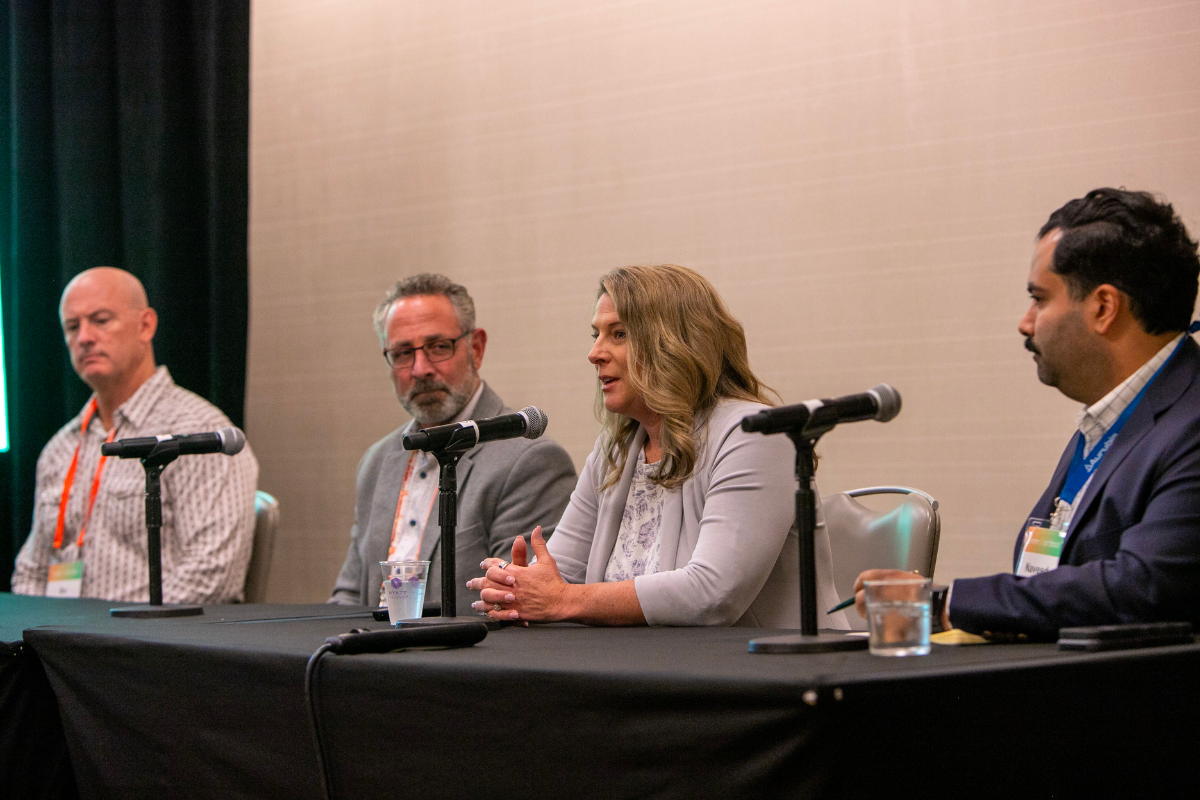
Speaking during the “Maximizing the Value of Your Precious Metals” session were (from left to right) session moderator Bo Guilbeault of Starbucks, John Antonacci of Gannon & Scott, Kristina Picciotti of Global Electronic Recycling, and Naveed Moghadam of Aurubis. | Big Wave Productions
Each company has its own niche in the e-scrap and ITAD game, and by looking at other players as potential collaborators rather than fierce competitors, everyone can benefit financially. That was one takeaway from a recent conversation between a collector, refiner and smelter operator.
“We’re all in the same business, competing for the same kind of business, but if we use each other’s strengths we’re better and stronger for the client,” said Kristina Picciotti, CEO of Global Electronic Recycling.
Picciotti spoke during “Maximizing the Value of Your Precious Metals,” a session at the 2023 E-Scrap and E-Reuse Conference in New Orleans. She was joined by John Antonacci, vice president of sales and marketing for Gannon & Scott; and Naveed Moghadam, commercial director of North America for Aurubis. The session was moderated by Bo Guilbeault, who handles IT asset management for Starbucks.
The speakers were well positioned to talk about all stages of the asset disposition process. GER does ITAD work, collecting assets and doing data destruction for all manner of clients. Gannon & Scott brings in material from companies like GER, aggregates it and processes it in various ways to prepare for sending it to a smelter, such as Aurubis. Aurubis performs the final stage of processing, smelting material and taking it all the way to the point of selling precious metals on the market.
Communication is key to facilitating the kind of collaboration Picciotti described. As an example, the speakers discussed how much sortation and separation an upstream processor should do, to maximize return. From a smelter perspective, upstream processors separating material by grade is a big plus for all parties: Smelters like to know what they’re getting so they can plan how to load their furnaces, said Moghadam of Aurubis.
“The more that our partners know their material, the better off we are,” Moghadam said.
Aurubis likes to have conversations with its suppliers about when it makes sense to take steps like extra separation, in order to maximize everyone’s return. Rather than the smelter occasionally making a little bit more because some high-grade boards are mixed in with low-grade, Aurubis values consistency, creating sustainable business relationships, Moghadam said. “We’re looking for the long term,” he said.
Moghadam added that the days of looking at any possible competitor as an enemy are long gone, given the benefit that comes from working with each other and benefiting from each company’s niche.
“You have to know who else is in there and see what are the ways you can collaborate,” he said.
Antonacci of Gannon & Scott noted there is similar collaboration among refiners that might otherwise seem to be competitors. Each refiner has its own little niche, he said. Sometimes Gannon & Scott receives material from a competitor based on the refinery’s burn capacity or current filter configuration.
“They might not want to tie up their equipment so they’ll send us that material to process for them,” Antonacci said.
Driven by data
Collecting and analyzing information is also key: Data “outweighs any commodity as far as the value,” Guilbeault of Starbucks said.
Picciotti offered an example of when she took the reins at GER in 2020, after former owner and founder Gary Kirkpatrick’s death. Picciotti had been with GER since 2012, but when she took over as CEO, she faced a learning curve, particularly when it came to component and material value.
Kirkpatrick had decades of experience valuing materials, and he could value and sort circuit boards at a glance. Picciotti didn’t have the same level of instinctive knowledge about board value, so she leaned on a different skill.
“My method was data,” Picciotti said. She began collecting and compiling data points, and she did so by sending material to Gannon & Scott to get an accurate understanding of what GER’s material stream looked like.
“We had used a smelter and downstream recyclers, but we rarely if ever used a refinery to understand how much precious metal could be recovered,” Picciotti said. The data GER received back from Gannon & Scott helped guide processing decisions to maximize recovered value.
Guilbeault advised a similar data-gathering process, especially for newer ITAD processors, in order to “really understand the math.”

